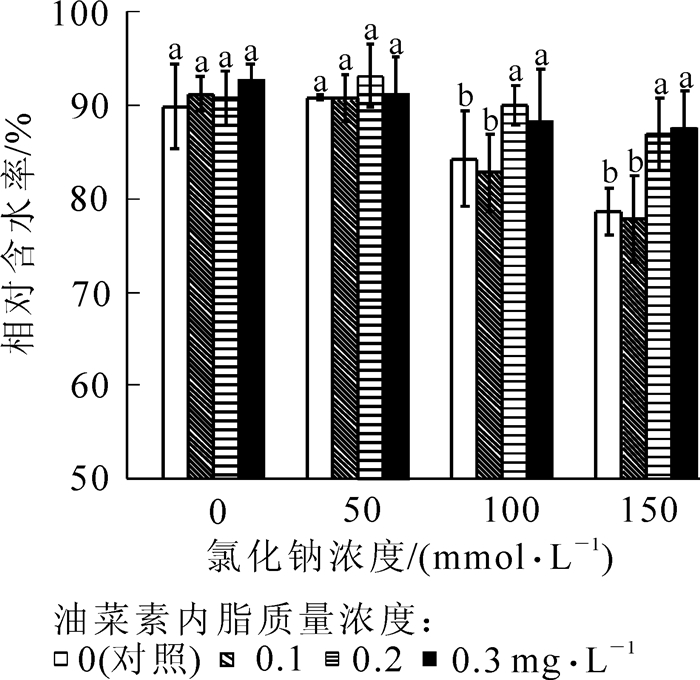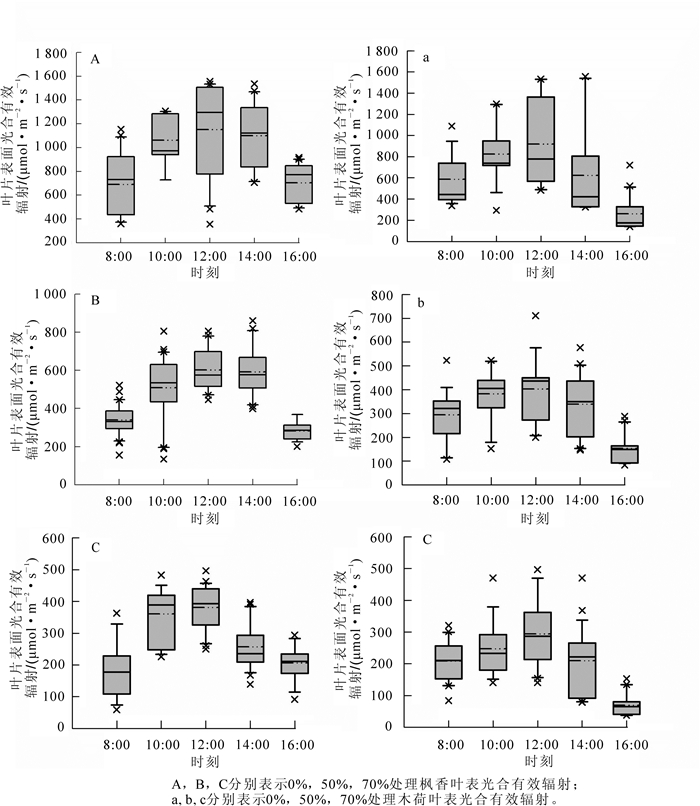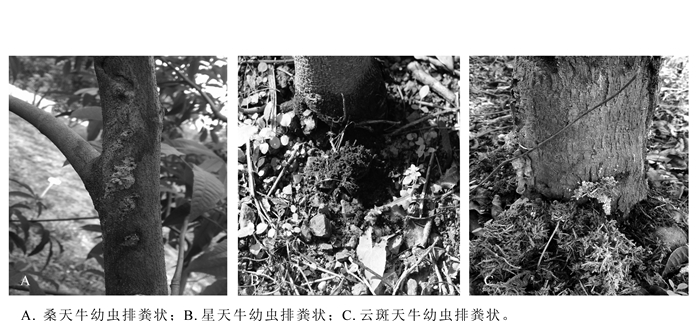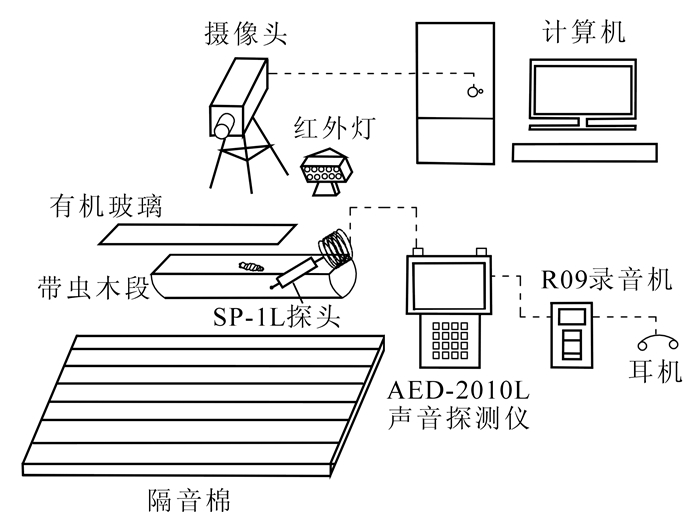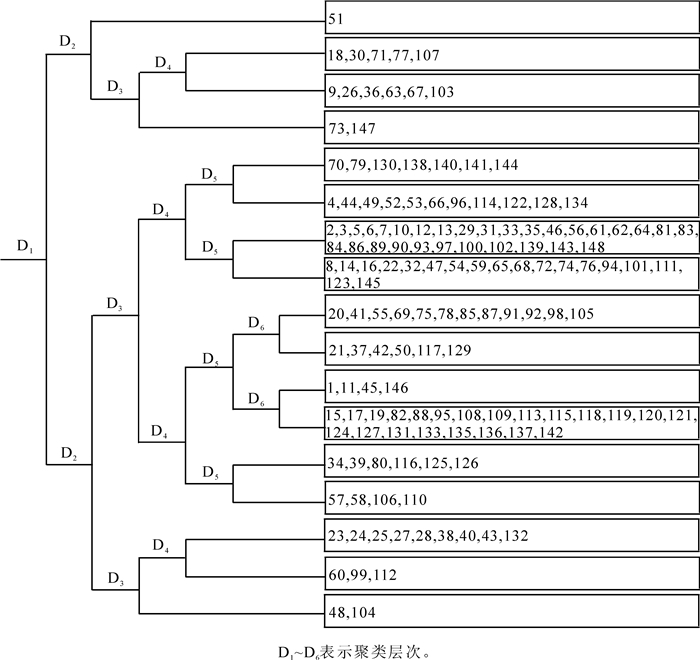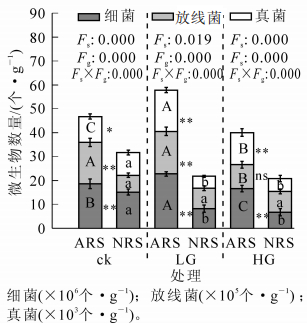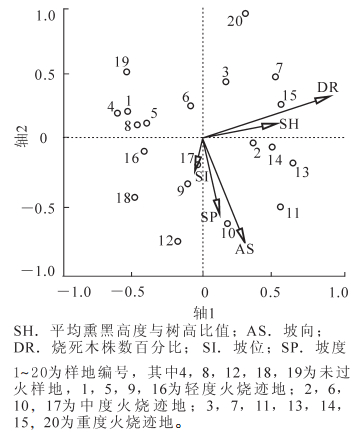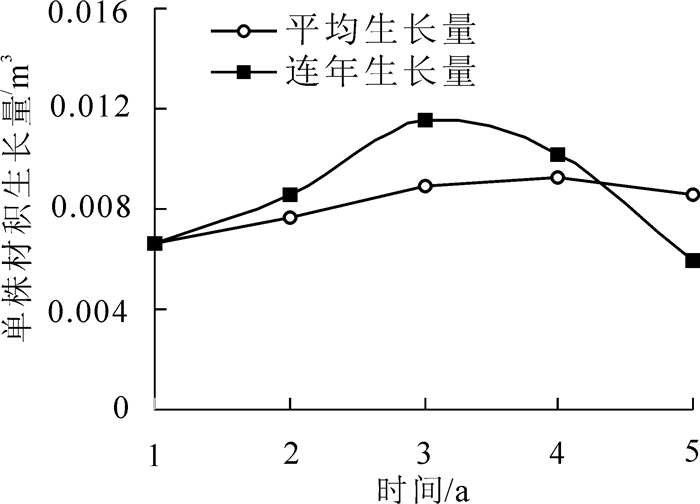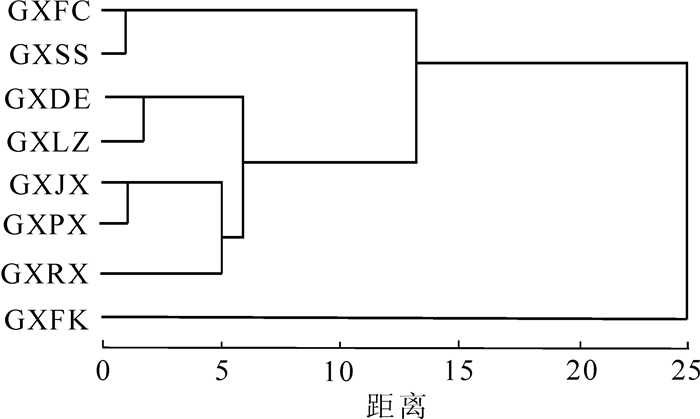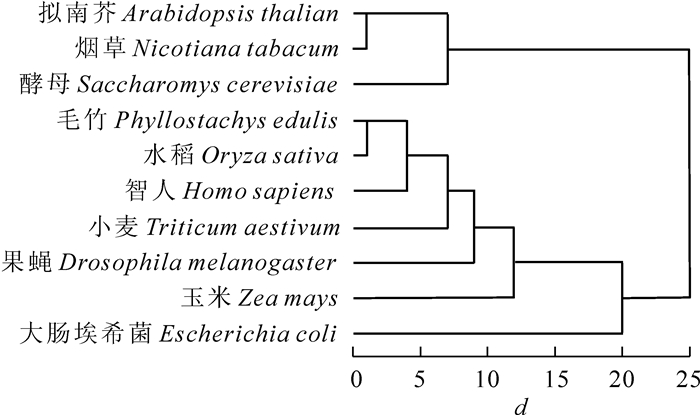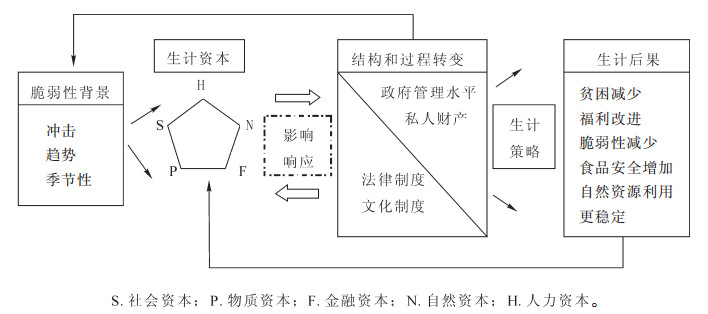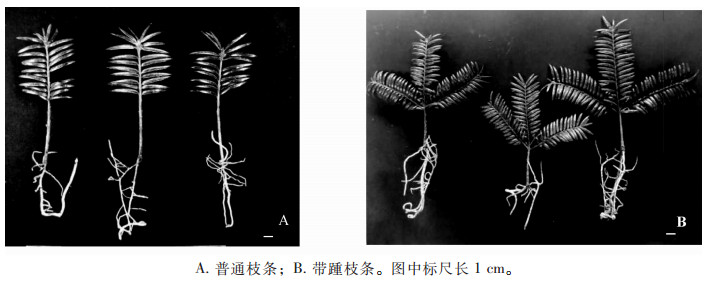2017 Vol. 34, No. 1
2017, 34(1): 1-6.
doi: 10.11833/j.issn.2095-0756.2017.01.001
Abstract:
To research bending behavior of wood-aluminum composites (WAC) and the effect of stacking sequences, orient strand boards (OSB) were laminated with aluminum alloy sheets by different stacking sequencesto manufacture WACs. Then, the bending modulus of elasticity (MOE) and bearing capacity of the WAC were determined using a three-point bending test. Next, a prediction model was established from classical laminated plate theory and validated based on the effect of the glue line. Experimental results indicated that WAC with the structure locating the aluminum alloy sheeton the surface showed the best bending performance. The peak load of WAC, which composite the aluminum alloy sheeton the surface, was 2-fold greater than OSB. In contrast with OSB, the bending MOE for the aluminum alloy sheeton the surface increased 156.55% along the parallel and 192.79% along the perpendicular. The model based on classical laminated plate theory was precise enough to aim at a theoretical MOE with relative error of less than 10%.
To research bending behavior of wood-aluminum composites (WAC) and the effect of stacking sequences, orient strand boards (OSB) were laminated with aluminum alloy sheets by different stacking sequencesto manufacture WACs. Then, the bending modulus of elasticity (MOE) and bearing capacity of the WAC were determined using a three-point bending test. Next, a prediction model was established from classical laminated plate theory and validated based on the effect of the glue line. Experimental results indicated that WAC with the structure locating the aluminum alloy sheeton the surface showed the best bending performance. The peak load of WAC, which composite the aluminum alloy sheeton the surface, was 2-fold greater than OSB. In contrast with OSB, the bending MOE for the aluminum alloy sheeton the surface increased 156.55% along the parallel and 192.79% along the perpendicular. The model based on classical laminated plate theory was precise enough to aim at a theoretical MOE with relative error of less than 10%.
2017, 34(1): 7-13.
doi: 10.11833/j.issn.2095-0756.2017.01.002
Abstract:
To study the aggregation behavior of a lignin-amine aqueous solution in dilute hydrochloric acid and the influence of inorganic salts and pH on the aggregation behavior of lignin-amine, measurements of surface tension, absorbance, particle size, and Zeta potential were taken using a surface tensiometer, an ultraviolet spectrophotometer, and a Zetasizer Nano ZS lazer particle analyzer. Results showed that the critical aggregation concentration (CAC) of lignin-amine was 0.10 g·L-1. Lignin-amine mainly existed in the form of single molecules in solution when its concentration was under the CAC and in the form of multi-molecular aggregation if the concentration was much greater than the CAC. The Zeta potential of lignin-amine increased from 18.1 mV to the maximum of 37.6 mV when the concentration of lignin-amine increased from 0.01 g·L-1 to 2.00 g·L-1, and then decreased to 35.8 mV when the concentration increased continuously to 10.00 g·L-1. Lignin-amine showed a surface tension of 44.09 mN·m-1 at a concentration of 10.00 g·L-1. If inorganic salts were added to the solution, lignin-amine would easily aggregate into larger particles and form a precipitate. Similarly, when the pH of the solution was less than 1, lignin-amine also aggregated into larger particles and formed a precipitate. Thus, lignin-amine solution in dilute hydrochloric acid at pH 2 was a colloidal solution with positive charges, and its aggregation behavior was strongly effected by its concentration, Zeta potential, inorganic salts and pH in the solution.
To study the aggregation behavior of a lignin-amine aqueous solution in dilute hydrochloric acid and the influence of inorganic salts and pH on the aggregation behavior of lignin-amine, measurements of surface tension, absorbance, particle size, and Zeta potential were taken using a surface tensiometer, an ultraviolet spectrophotometer, and a Zetasizer Nano ZS lazer particle analyzer. Results showed that the critical aggregation concentration (CAC) of lignin-amine was 0.10 g·L-1. Lignin-amine mainly existed in the form of single molecules in solution when its concentration was under the CAC and in the form of multi-molecular aggregation if the concentration was much greater than the CAC. The Zeta potential of lignin-amine increased from 18.1 mV to the maximum of 37.6 mV when the concentration of lignin-amine increased from 0.01 g·L-1 to 2.00 g·L-1, and then decreased to 35.8 mV when the concentration increased continuously to 10.00 g·L-1. Lignin-amine showed a surface tension of 44.09 mN·m-1 at a concentration of 10.00 g·L-1. If inorganic salts were added to the solution, lignin-amine would easily aggregate into larger particles and form a precipitate. Similarly, when the pH of the solution was less than 1, lignin-amine also aggregated into larger particles and formed a precipitate. Thus, lignin-amine solution in dilute hydrochloric acid at pH 2 was a colloidal solution with positive charges, and its aggregation behavior was strongly effected by its concentration, Zeta potential, inorganic salts and pH in the solution.
2017, 34(1): 14-19.
doi: 10.11833/j.issn.2095-0756.2017.01.003
Abstract:
Nitrogen (N), a necessary plant nutrient for plant growth can be applied as nitrate nitrogen (NO3--N) or ammonium nitrogen (NH4+-N) but may have different effects on nutrient absorption and physiological metabolism of the plant. To determine a proper N fertilizer for Phyllostachys violascens cultivation, an experiment supplying N fertilizer with five different ratios of NO3--N and NH4+-N (1:0, 2:1, 1:1, 1:2, and 0:1) was conducted. Contents of malondialdehvde (MDA), soluble protein, and antioxidant enzyme activities were determined. Results showed that for the same treatment ratios of NO3--N and NH4+-N, MDA content, soluble protein, and antioxidant enzyme activities were higher in leaves than in roots. As the concentration of NH4+-N increased, the MDA content in leaves and roots first decreased and then increased with the lowest MDA having a ratio of 1:1. Antioxidant enzyme activities first increased and then generally decreased having higher levels with mixotrophism. Superoxide dismutase (SOD) and catalase (CAT) activities in leaves were highest with the 1:2 ratio; whereas SOD activity in roots was highest with the 1:1 ratio, and CAT and peroxidase (POD) activities were highest with the 1:2 ratio. Soluble protein content also increased first and then decreased with the highest for leaves in a 1:2 ratio and for roots in a 1:1 ratio. With mixed nutrition, MDA content was lower, but soluble protein content and antioxidant enzyme activities remained at much higher levels. Thus, with a mixture of NO3--N and NH4+-N at a 1:1 ratio, the degree of oxidative damage to leaves and roots of Phyllostachys violascens was least, and antioxidant enzyme activities were stronger, thereby boosting growth and biomass accumulation.
Nitrogen (N), a necessary plant nutrient for plant growth can be applied as nitrate nitrogen (NO3--N) or ammonium nitrogen (NH4+-N) but may have different effects on nutrient absorption and physiological metabolism of the plant. To determine a proper N fertilizer for Phyllostachys violascens cultivation, an experiment supplying N fertilizer with five different ratios of NO3--N and NH4+-N (1:0, 2:1, 1:1, 1:2, and 0:1) was conducted. Contents of malondialdehvde (MDA), soluble protein, and antioxidant enzyme activities were determined. Results showed that for the same treatment ratios of NO3--N and NH4+-N, MDA content, soluble protein, and antioxidant enzyme activities were higher in leaves than in roots. As the concentration of NH4+-N increased, the MDA content in leaves and roots first decreased and then increased with the lowest MDA having a ratio of 1:1. Antioxidant enzyme activities first increased and then generally decreased having higher levels with mixotrophism. Superoxide dismutase (SOD) and catalase (CAT) activities in leaves were highest with the 1:2 ratio; whereas SOD activity in roots was highest with the 1:1 ratio, and CAT and peroxidase (POD) activities were highest with the 1:2 ratio. Soluble protein content also increased first and then decreased with the highest for leaves in a 1:2 ratio and for roots in a 1:1 ratio. With mixed nutrition, MDA content was lower, but soluble protein content and antioxidant enzyme activities remained at much higher levels. Thus, with a mixture of NO3--N and NH4+-N at a 1:1 ratio, the degree of oxidative damage to leaves and roots of Phyllostachys violascens was least, and antioxidant enzyme activities were stronger, thereby boosting growth and biomass accumulation.
2017, 34(1): 20-27.
doi: 10.11833/j.issn.2095-0756.2017.01.004
Abstract:
To provide a theoretical basis for improvement of Cinnamomum camphora (camphor) salt resistance, a photosynthetic adjustment function of the brassinosteroids (BRs) root treatment to camphor with NaCl stress was studied. Potted plants having different concentrations (0.1, 0.2 and 0.3 mg·L-1) of BR root treatments were added to camphor seedlings with distilled water as a control. Salt stress was applied with NaCl concentrations of 0, 50, 100, and 150 mmol·L-1, 3 replications was designed. Results showed that BRs reduced the salt injury index. With an increase in salt concentration, BRs also lessened the decrease in Chla, Chlb, Chl, Car, and Chla/b; improved the increase in range of Car/Chl. When the salt concentrations from 100 mmol·L-1 to 150 mmol·L-1, BRs can inhibit the decrease in Chla/b and the increase in range of Car/Chl signifigantly (P < 0.05). BRs can also improved the relative water content of leaves, Fv/Fm, Fv/Fo, Fv'/Fm', and ФPSⅡ for salt stress with higher values; improved the photochemical energy dissipation, and when the concentrations of BRs is 0.2 and 0.3 mg·L-1, it can improved the relative water, Fv/Fm, Fv/Fo and the photochemical energy dissipation signifigantly (P < 0.05). Thus, with camphor, BRs were beneficial for capturing, absorbing, transferring, and converting light energy, for improving leaf photosynthetic activity, for alleviating the impact of high salt stress on the photosynthetic system, and for reducing the inhibitive effect of high salt on camphor.
To provide a theoretical basis for improvement of Cinnamomum camphora (camphor) salt resistance, a photosynthetic adjustment function of the brassinosteroids (BRs) root treatment to camphor with NaCl stress was studied. Potted plants having different concentrations (0.1, 0.2 and 0.3 mg·L-1) of BR root treatments were added to camphor seedlings with distilled water as a control. Salt stress was applied with NaCl concentrations of 0, 50, 100, and 150 mmol·L-1, 3 replications was designed. Results showed that BRs reduced the salt injury index. With an increase in salt concentration, BRs also lessened the decrease in Chla, Chlb, Chl, Car, and Chla/b; improved the increase in range of Car/Chl. When the salt concentrations from 100 mmol·L-1 to 150 mmol·L-1, BRs can inhibit the decrease in Chla/b and the increase in range of Car/Chl signifigantly (P < 0.05). BRs can also improved the relative water content of leaves, Fv/Fm, Fv/Fo, Fv'/Fm', and ФPSⅡ for salt stress with higher values; improved the photochemical energy dissipation, and when the concentrations of BRs is 0.2 and 0.3 mg·L-1, it can improved the relative water, Fv/Fm, Fv/Fo and the photochemical energy dissipation signifigantly (P < 0.05). Thus, with camphor, BRs were beneficial for capturing, absorbing, transferring, and converting light energy, for improving leaf photosynthetic activity, for alleviating the impact of high salt stress on the photosynthetic system, and for reducing the inhibitive effect of high salt on camphor.
2017, 34(1): 28-35.
doi: 10.11833/j.issn.2095-0756.2017.01.005
Abstract:
The area of evergreen broad-leaf forest reversely evolved into the secondary brush community which was lower yields, weaker resistance ability and less diversity. So it was important to investigate that if it is helpful for trees growth to decrease the light intensity for sapling trees in the secondary brush stand which had a stronger light than evergreen broad-leaf forest. Schima superba and Liquidambar formosana were used in this experiment as materials to study the effects of three different shading levels (shading of 0%, 50%, and 70%) on their photosynthetic characteristics. The experiment was set in a secondary bush community in Lin'an, Zhejiang. Some of the leaf characteristics, photosynthetic pigment content, chlorophyll fluorescence parameters, and net photosynthetic rate were measured. Each species were selected 10 trees as samples in every shading level, and 5 trees were chosen to measure the indicators mentioned above. Results showed that compared to the full light treatment, specific leaf area (SLA), relative water content, and photosynthetic pigment content in the shade treatments of both species increased significantly (P < 0.05). The Fv/Fm value of L. formosana under shading was lower than that in full lightreaching 0.74 at 70% shading; whereas, Fv/Fm values of S. superba were in the range of 0.75-0.85 in three different treatments. The net photosynthetic rate of S. superba with 50% shading (8.11 μmol·m-2·s-1) was higher than the full light treatment (4.64 μmol·m-2·s-1) at 12:00. Thus, S. superba which was more shade-tolerant than L. formosana could live in a wider range of light intensities including secondary bush community succession stages in the subtropics where it belonged to intermediate forest succession.
The area of evergreen broad-leaf forest reversely evolved into the secondary brush community which was lower yields, weaker resistance ability and less diversity. So it was important to investigate that if it is helpful for trees growth to decrease the light intensity for sapling trees in the secondary brush stand which had a stronger light than evergreen broad-leaf forest. Schima superba and Liquidambar formosana were used in this experiment as materials to study the effects of three different shading levels (shading of 0%, 50%, and 70%) on their photosynthetic characteristics. The experiment was set in a secondary bush community in Lin'an, Zhejiang. Some of the leaf characteristics, photosynthetic pigment content, chlorophyll fluorescence parameters, and net photosynthetic rate were measured. Each species were selected 10 trees as samples in every shading level, and 5 trees were chosen to measure the indicators mentioned above. Results showed that compared to the full light treatment, specific leaf area (SLA), relative water content, and photosynthetic pigment content in the shade treatments of both species increased significantly (P < 0.05). The Fv/Fm value of L. formosana under shading was lower than that in full lightreaching 0.74 at 70% shading; whereas, Fv/Fm values of S. superba were in the range of 0.75-0.85 in three different treatments. The net photosynthetic rate of S. superba with 50% shading (8.11 μmol·m-2·s-1) was higher than the full light treatment (4.64 μmol·m-2·s-1) at 12:00. Thus, S. superba which was more shade-tolerant than L. formosana could live in a wider range of light intensities including secondary bush community succession stages in the subtropics where it belonged to intermediate forest succession.
2017, 34(1): 36-41.
doi: 10.11833/j.issn.2095-0756.2017.01.006
Abstract:
Strigolactones are a class of carotenoid-derived compounds and play as novel signaling molecules to regulate various processes of growth and development in plant. For understanding the roles of strigolactone and its signaling protein in plant photosynthesis, we measured the contents of photosynthetic pigments and chlorophyll fluorescence parameters in the leaves of strigolactone biosynthesis mutant max1, strigolactone insensitive mutants max2 and wild type of Arabidopsis thaliana, and the results showed that features of photosynthetic fluorescence are obvious differences in max1 and max2 mutants. The contents of chlorophyll and values of photochemical-related parameters weren't significantly decreased in max1 mutant, but ratio of content of chlorophyll a to chlorophyll b was reduced and the value of minimal fluorescence (Fo) and Y (NO) were increased than WT plant. Furthermore, rapid light-response curve of PSⅡ chlorophyll fluorescence parameters showed that the value of electron transport rate through PSⅡ (ETR), Y (Ⅱ) and QNP in max1 mutant is lower than WT under intensive light. However, in max2 mutant, the contents of chlorophyll and values of photochemical-related parameters including maximum quantum efficiency of PSⅡ photochemistry (Fv/Fm), actual photochemical rate of PSⅡ[Y (Ⅱ)]and photochemical dissipation (qP) are significantly lower than WT (P < 0.05), while the values of photoprotection-related parameters, such as nonphotochemical quenching (QNP) and non-photochemical dissipation (qP), are significantly higher than WT (P < 0.05). These results demonstrated that strigolactone are possibly involved in modulating photosynthesis adaptability in response to environmental cues, and MAX2 protein has specific roles in plant photosystem and photosynthesis that different with strigolactone, which possibly participates in regulation of structure of photosystem of plant.
Strigolactones are a class of carotenoid-derived compounds and play as novel signaling molecules to regulate various processes of growth and development in plant. For understanding the roles of strigolactone and its signaling protein in plant photosynthesis, we measured the contents of photosynthetic pigments and chlorophyll fluorescence parameters in the leaves of strigolactone biosynthesis mutant max1, strigolactone insensitive mutants max2 and wild type of Arabidopsis thaliana, and the results showed that features of photosynthetic fluorescence are obvious differences in max1 and max2 mutants. The contents of chlorophyll and values of photochemical-related parameters weren't significantly decreased in max1 mutant, but ratio of content of chlorophyll a to chlorophyll b was reduced and the value of minimal fluorescence (Fo) and Y (NO) were increased than WT plant. Furthermore, rapid light-response curve of PSⅡ chlorophyll fluorescence parameters showed that the value of electron transport rate through PSⅡ (ETR), Y (Ⅱ) and QNP in max1 mutant is lower than WT under intensive light. However, in max2 mutant, the contents of chlorophyll and values of photochemical-related parameters including maximum quantum efficiency of PSⅡ photochemistry (Fv/Fm), actual photochemical rate of PSⅡ[Y (Ⅱ)]and photochemical dissipation (qP) are significantly lower than WT (P < 0.05), while the values of photoprotection-related parameters, such as nonphotochemical quenching (QNP) and non-photochemical dissipation (qP), are significantly higher than WT (P < 0.05). These results demonstrated that strigolactone are possibly involved in modulating photosynthesis adaptability in response to environmental cues, and MAX2 protein has specific roles in plant photosystem and photosynthesis that different with strigolactone, which possibly participates in regulation of structure of photosystem of plant.
2017, 34(1): 42-49.
doi: 10.11833/j.issn.2095-0756.2017.01.007
Abstract:
A variety of longhorned beetles simultaneously occur on Carya cathayensis host with increasingly serious damage, which become an important factor limiting the pecan production. To explain the damage profile from longhorned beetle species and to help prevent and control damage on a Carya cathayensis forest, we carried on a systematic research on a C. cathayensis forest in Lin'an to study damage from the species, recognition of typical damage shapes, and identification methods of different species by host anatomy, morphological identification and molecular identification method. Results showed that there were mainly three longhorned beetle species, Apriona germari, Anoplophora chinensis, and Batocera horsfieldi in the C. cathayensis forest of Lin'an. A. germari larvae were 100% distributed on branches, A. chinensis larvae were 100% on roots and trunks 30 cm below ground, and B. horsfieldi larvae were 93.9% distributed on the trunk 0-150 cm above ground. Different species of longhorned beetle larvae produced different typical symptoms for the shape of the damage due to defecation, larvae burrows, and oviposition grooves. There were strong morphological differences between male and female adults of A. germari, A. chinensis, and B. horsfieldi. In addition, the larvae pronotum of these three species of longhorned beetles had different typical characteristics making it possible to quickly and accurately distinguish the type of longhorned beetle species. Corresponding molecular identification results also proved the accuracy of this method. We speculate that B. horsfieldi and A. chinensis mainly damage adult C. cathayensis trees, and A. germari mainly damage young ones with different species of longhorned beetle larvae occupying different niches. In addition, different typical symptoms and morphological characteristics could be important in preventing and controlling C. cathayensis longhorned beetles.
A variety of longhorned beetles simultaneously occur on Carya cathayensis host with increasingly serious damage, which become an important factor limiting the pecan production. To explain the damage profile from longhorned beetle species and to help prevent and control damage on a Carya cathayensis forest, we carried on a systematic research on a C. cathayensis forest in Lin'an to study damage from the species, recognition of typical damage shapes, and identification methods of different species by host anatomy, morphological identification and molecular identification method. Results showed that there were mainly three longhorned beetle species, Apriona germari, Anoplophora chinensis, and Batocera horsfieldi in the C. cathayensis forest of Lin'an. A. germari larvae were 100% distributed on branches, A. chinensis larvae were 100% on roots and trunks 30 cm below ground, and B. horsfieldi larvae were 93.9% distributed on the trunk 0-150 cm above ground. Different species of longhorned beetle larvae produced different typical symptoms for the shape of the damage due to defecation, larvae burrows, and oviposition grooves. There were strong morphological differences between male and female adults of A. germari, A. chinensis, and B. horsfieldi. In addition, the larvae pronotum of these three species of longhorned beetles had different typical characteristics making it possible to quickly and accurately distinguish the type of longhorned beetle species. Corresponding molecular identification results also proved the accuracy of this method. We speculate that B. horsfieldi and A. chinensis mainly damage adult C. cathayensis trees, and A. germari mainly damage young ones with different species of longhorned beetle larvae occupying different niches. In addition, different typical symptoms and morphological characteristics could be important in preventing and controlling C. cathayensis longhorned beetles.
2017, 34(1): 50-55.
doi: 10.11833/j.issn.2095-0756.2017.01.008
Abstract:
Acoustic detection technology is a promising method to monitor hidden pests. Defining characteristics about different acoustic behaviors of pests is beneficial to improve the accuracy of acoustic detection technology, can eliminate interference between different acoustic behaviors to help identify species and pest activities. This study explored and analyzed acoustic behaviors for different cerambycid larvae of Anoplophora glabripennis and Anoplophora chinensis by using an infrared monitoring and acoustic detection system. Results showed four types of acoustic behaviors:feeding, moving, cleaning, and self-protection, with feeding sounds having the largest proportion (34%). Time-domain graphs revealed differences with maximum amplitude, waveform, and pulse duration. Energy distribution and frequency band in spectrograms also showed differences. Single sound pulse duration and dominant frequency of acoustic behaviors had different characteristic values. Pulse duration of the feeding sound was short (25.96 ms for A. glabripennis and 24.28 ms for A. chinensis). The highest dominant frequency was with the feeding sound (exceeding 7.00 kHz). This study produced helpful information regarding elimination of noise and showed that in practical application the feeding sound could be easily identified with short pulse duration, large amplitude, and high frequency.
Acoustic detection technology is a promising method to monitor hidden pests. Defining characteristics about different acoustic behaviors of pests is beneficial to improve the accuracy of acoustic detection technology, can eliminate interference between different acoustic behaviors to help identify species and pest activities. This study explored and analyzed acoustic behaviors for different cerambycid larvae of Anoplophora glabripennis and Anoplophora chinensis by using an infrared monitoring and acoustic detection system. Results showed four types of acoustic behaviors:feeding, moving, cleaning, and self-protection, with feeding sounds having the largest proportion (34%). Time-domain graphs revealed differences with maximum amplitude, waveform, and pulse duration. Energy distribution and frequency band in spectrograms also showed differences. Single sound pulse duration and dominant frequency of acoustic behaviors had different characteristic values. Pulse duration of the feeding sound was short (25.96 ms for A. glabripennis and 24.28 ms for A. chinensis). The highest dominant frequency was with the feeding sound (exceeding 7.00 kHz). This study produced helpful information regarding elimination of noise and showed that in practical application the feeding sound could be easily identified with short pulse duration, large amplitude, and high frequency.
2017, 34(1): 56-62.
doi: 10.11833/j.issn.2095-0756.2017.01.009
Abstract:
To determine the characteristics of the Collembola community in the litter layer of typical artificial plantations, Cryptomeria fortunei, Phoebe zhennan, Metasequoia glyptostroboides, and a secondary-forest were selected and studied in May, July, September, and November of 2013. Analysis included a similarity index. Results comprised a total collection of 1 496 samples of soil fauna belonging to 11 families. Of these, 290 belonging to 9 families were found in M. glyptostroboides stands, 352 belonging to 7 families were collected in Phoebe zhennan plots, 768 belonging to 11 families were collected in C. fortunei stands, and 86 belonging to 6 families were collected in the secondary-forest. The highest number of Collembola for each month was found in C. fortunei, and the lowest number (except for May) was found in the secondary-forest. In each forest type, Isotomidae, Sminthuridae, and Entomobryidae were the dominant families. No direct relation between the individual number and families of Collembola and litter accumulation were found. Also, the similarity index studies showed that the highest value was found in September (excepting July), and the smallest values were found in May and July.
To determine the characteristics of the Collembola community in the litter layer of typical artificial plantations, Cryptomeria fortunei, Phoebe zhennan, Metasequoia glyptostroboides, and a secondary-forest were selected and studied in May, July, September, and November of 2013. Analysis included a similarity index. Results comprised a total collection of 1 496 samples of soil fauna belonging to 11 families. Of these, 290 belonging to 9 families were found in M. glyptostroboides stands, 352 belonging to 7 families were collected in Phoebe zhennan plots, 768 belonging to 11 families were collected in C. fortunei stands, and 86 belonging to 6 families were collected in the secondary-forest. The highest number of Collembola for each month was found in C. fortunei, and the lowest number (except for May) was found in the secondary-forest. In each forest type, Isotomidae, Sminthuridae, and Entomobryidae were the dominant families. No direct relation between the individual number and families of Collembola and litter accumulation were found. Also, the similarity index studies showed that the highest value was found in September (excepting July), and the smallest values were found in May and July.
2017, 34(1): 63-67.
doi: 10.11833/j.issn.2095-0756.2017.01.010
Abstract:
To determine the storage temperature and pollen viability of Pinus yunnanensis, different storage conditions of 25℃, 5℃, and -20℃ were used to study variation in pollen viability. Different treatments of sucrose, H3BO3, GA3, and CaCl2 were used to determine the effects on pollen germination. Analysis employed orthogonal experiments alone as well as interactions. Results showed that pollen viability was 91.8% at 0 d and then decreased with greater storage time at temperatures of 25℃ > 5℃ > -20℃. Germination tests showed that the optimal concentration and the corresponding germination rate were as follows:sucrose-80 g·L-1 and 82.4%, GA3-100 mg·L-1 and 66.4%, H3BO3-300 mg·L-1 and 18.2%, and CaCl2-100 mg·L-1 and 57.0%. The best combination of four factors was 120 g·L-1 sucrose+150 mg·L-1 GA3+100 mg·L-1 H3BO3+100 mg·L-1 CaCl2 with a pollen germination rate of 89.7%. Meanwhile, above a certain concentration of the culture medium had inhibitory effects on pollen germination. Thus, low temperatures increased pollen storage time.
To determine the storage temperature and pollen viability of Pinus yunnanensis, different storage conditions of 25℃, 5℃, and -20℃ were used to study variation in pollen viability. Different treatments of sucrose, H3BO3, GA3, and CaCl2 were used to determine the effects on pollen germination. Analysis employed orthogonal experiments alone as well as interactions. Results showed that pollen viability was 91.8% at 0 d and then decreased with greater storage time at temperatures of 25℃ > 5℃ > -20℃. Germination tests showed that the optimal concentration and the corresponding germination rate were as follows:sucrose-80 g·L-1 and 82.4%, GA3-100 mg·L-1 and 66.4%, H3BO3-300 mg·L-1 and 18.2%, and CaCl2-100 mg·L-1 and 57.0%. The best combination of four factors was 120 g·L-1 sucrose+150 mg·L-1 GA3+100 mg·L-1 H3BO3+100 mg·L-1 CaCl2 with a pollen germination rate of 89.7%. Meanwhile, above a certain concentration of the culture medium had inhibitory effects on pollen germination. Thus, low temperatures increased pollen storage time.
2017, 34(1): 68-77.
doi: 10.11833/j.issn.2095-0756.2017.01.011
Abstract:
In order to explore the relationship between the spatial distribution pattern of public forest communities and environmental factors, the 148 plots (20 m×20 m for each) of public welfware forest in Jinyun were studied by two-way indicator species analysis (TWINSPAN) and canonical correspondence analysis (CCA). The results showed that 148 plots could be divided into 17 groups by TWINSPAN, which reflected that the group of Pinus massoniana and Cunninghamia lanceolata as constructive species were the dominant communities in Jinyun. The result of CCA revealed that the elevation and the slope were the main determinants of community distribution in the area. Quantitative classification and CCA can be used to conduct a comprehensive analysis of the relationship between distribution patterns of vegetation and environment and therefore will provide more scientific and reasonable basis for the classification of public welfare forest management units.
In order to explore the relationship between the spatial distribution pattern of public forest communities and environmental factors, the 148 plots (20 m×20 m for each) of public welfware forest in Jinyun were studied by two-way indicator species analysis (TWINSPAN) and canonical correspondence analysis (CCA). The results showed that 148 plots could be divided into 17 groups by TWINSPAN, which reflected that the group of Pinus massoniana and Cunninghamia lanceolata as constructive species were the dominant communities in Jinyun. The result of CCA revealed that the elevation and the slope were the main determinants of community distribution in the area. Quantitative classification and CCA can be used to conduct a comprehensive analysis of the relationship between distribution patterns of vegetation and environment and therefore will provide more scientific and reasonable basis for the classification of public welfare forest management units.
2017, 34(1): 78-85.
doi: 10.11833/j.issn.2095-0756.2017.01.012
Abstract:
Estimation of carbon fluxes is an important data basis for assessing forest ecosystem carbon cycling with the most widely used and effective method of measurement, the eddy covariance method, having advantages in accuracy but being limited in the scope of observation as it has a greater error when estimating net primary productivity (NPP) over large areas of a forest ecosystem. To study the application of wireless sensor networks for ecological monitoring and to estimate net primary production on a large scale, a wireless sensor network was developed in the vicinity of a flux observation tower in a bamboo stand of Anji, Zhejiang. The continuous meteorological data of radiation, temperature and humidity was collected from January to September in 2015. According to the simplified algorithm of model parameter, data collected from the wireless sensor network was used as the driving variable of the model, and NPP was evaluated. Results showed that (1) the meteorological data collected by wireless sensor network were consistent with the observed data of the flux tower, the determination coefficient of the two light radiation is 0.77. (2) Compared with measured value, the NPP evaluation of the bamboo stand based on wireless sensor network has a more consistent seasonal tendency with a 10.1% relative error. (3) With the increasement of the time scale of data synthesis, the error between the estimated value and the measured value is reduced. Among them, the synthetic accuracy of scale data of 10 days was highest, the RMSE and Std Dev were lowest and the value of RMSE and Std Dev were (0.048 7 mg·m-2·s-1) and (0.041 8 mg·m-2·s-1), respectively. Thus, as a new monitoring method, the wireless sensor network could be applied in a bamboo stand ecological system.
Estimation of carbon fluxes is an important data basis for assessing forest ecosystem carbon cycling with the most widely used and effective method of measurement, the eddy covariance method, having advantages in accuracy but being limited in the scope of observation as it has a greater error when estimating net primary productivity (NPP) over large areas of a forest ecosystem. To study the application of wireless sensor networks for ecological monitoring and to estimate net primary production on a large scale, a wireless sensor network was developed in the vicinity of a flux observation tower in a bamboo stand of Anji, Zhejiang. The continuous meteorological data of radiation, temperature and humidity was collected from January to September in 2015. According to the simplified algorithm of model parameter, data collected from the wireless sensor network was used as the driving variable of the model, and NPP was evaluated. Results showed that (1) the meteorological data collected by wireless sensor network were consistent with the observed data of the flux tower, the determination coefficient of the two light radiation is 0.77. (2) Compared with measured value, the NPP evaluation of the bamboo stand based on wireless sensor network has a more consistent seasonal tendency with a 10.1% relative error. (3) With the increasement of the time scale of data synthesis, the error between the estimated value and the measured value is reduced. Among them, the synthetic accuracy of scale data of 10 days was highest, the RMSE and Std Dev were lowest and the value of RMSE and Std Dev were (0.048 7 mg·m-2·s-1) and (0.041 8 mg·m-2·s-1), respectively. Thus, as a new monitoring method, the wireless sensor network could be applied in a bamboo stand ecological system.
2017, 34(1): 86-95.
doi: 10.11833/j.issn.2095-0756.2017.01.013
Abstract:
To understand the response mechanism of soil microbial biomass in the rhizosphere soil of Artemisia frigida, we measured the functional diversity of Artemisia frigida rhizosphere (ARS) and non-rhizosphere soil (NRS) microbial community under three levels (no, light and heavy) of manipulative grazing conditions using the Biolog EcoPlate analysis. Results showed that with different grazing intensities, the soil microbial population of ARS was significantly greater than NRS (P < 0.05) with bacteria playing a dominant role in all soil microbial species accounting for 88%-97%. The average well color development (AWCD), directly reflecting microbial activity and functional diversity, increased over time; whereas, AWCD for the two soil types significantly changed (P < 0.05) along with increased grazing intensity such that:LG-ARS > ck-ARS > ck-NRS > LG-NRS > HG-ARS > HG-NRS. The Simpson, Shannon-Wiener, richness, and McIntosh indexes of ck-ARS were all higher (P < 0.05) than HG-NRS, and for ARS, population density and diversity of microbial communities were higher (P < 0.05) than NRS. The PCA was used to obtain two principal components related to soil microbial biomass utilization and that explained separately 52.1% (PC1) and 17.2% (PC2). The carbon carboxylic and amino acid play a major role in the separation of principal components. Thus, A. frigida growth could increase diversity of the soil microbial community, weaken grazing disturbances, improve the soil micro-ecology, and prevent degradation of the grasslands.
To understand the response mechanism of soil microbial biomass in the rhizosphere soil of Artemisia frigida, we measured the functional diversity of Artemisia frigida rhizosphere (ARS) and non-rhizosphere soil (NRS) microbial community under three levels (no, light and heavy) of manipulative grazing conditions using the Biolog EcoPlate analysis. Results showed that with different grazing intensities, the soil microbial population of ARS was significantly greater than NRS (P < 0.05) with bacteria playing a dominant role in all soil microbial species accounting for 88%-97%. The average well color development (AWCD), directly reflecting microbial activity and functional diversity, increased over time; whereas, AWCD for the two soil types significantly changed (P < 0.05) along with increased grazing intensity such that:LG-ARS > ck-ARS > ck-NRS > LG-NRS > HG-ARS > HG-NRS. The Simpson, Shannon-Wiener, richness, and McIntosh indexes of ck-ARS were all higher (P < 0.05) than HG-NRS, and for ARS, population density and diversity of microbial communities were higher (P < 0.05) than NRS. The PCA was used to obtain two principal components related to soil microbial biomass utilization and that explained separately 52.1% (PC1) and 17.2% (PC2). The carbon carboxylic and amino acid play a major role in the separation of principal components. Thus, A. frigida growth could increase diversity of the soil microbial community, weaken grazing disturbances, improve the soil micro-ecology, and prevent degradation of the grasslands.
2017, 34(1): 96-103.
doi: 10.11833/j.issn.2095-0756.2017.01.014
Abstract:
To study the influence of fire disturbance and environmental factors on undergrowth vegetation changes in a Pinus tabulaeformis forest, burned areas of an artificial P. tabulaeformis forest in Liaoheyuan National Forest Park of Pingquan County, Hebei Province were used as research objects. The burned forest was divided into three levels according to the degree of burn:mild, moderate, and severe. And three repeated plots were set. Non-burned forests near the burned area were also used for control plots. A redundancy analysis (RDA) was conducted on undergrowth vegetation and environmental factors in the three degrees of the burned area and the non-burned forest. Analysis also determined the richness index (R), diversity index (H), and evenness index (J). Results showed that undergrowth regeneration after fire was largely influenced by tree mortality rate and slope aspect, but slope and slope position had little effect on important herbs. The importance value for herbs and shrubs showing different degrees of change after fire:compared to control plots the severe burned area had a sharp increase in the number of herbaceous species from 15 to 26 with the number of shrub species increasing from 3 to 6. With an increase in fire intensity, R and H showed an overall increase (P < 0.05); whereas, J decreased (P < 0.05). Thus, growth and changes in undergrowth vegetation after fire were jointly affected by fire and topographic factors with fire being conducive to regeneration of undergrowth vegetation partly.
To study the influence of fire disturbance and environmental factors on undergrowth vegetation changes in a Pinus tabulaeformis forest, burned areas of an artificial P. tabulaeformis forest in Liaoheyuan National Forest Park of Pingquan County, Hebei Province were used as research objects. The burned forest was divided into three levels according to the degree of burn:mild, moderate, and severe. And three repeated plots were set. Non-burned forests near the burned area were also used for control plots. A redundancy analysis (RDA) was conducted on undergrowth vegetation and environmental factors in the three degrees of the burned area and the non-burned forest. Analysis also determined the richness index (R), diversity index (H), and evenness index (J). Results showed that undergrowth regeneration after fire was largely influenced by tree mortality rate and slope aspect, but slope and slope position had little effect on important herbs. The importance value for herbs and shrubs showing different degrees of change after fire:compared to control plots the severe burned area had a sharp increase in the number of herbaceous species from 15 to 26 with the number of shrub species increasing from 3 to 6. With an increase in fire intensity, R and H showed an overall increase (P < 0.05); whereas, J decreased (P < 0.05). Thus, growth and changes in undergrowth vegetation after fire were jointly affected by fire and topographic factors with fire being conducive to regeneration of undergrowth vegetation partly.
2017, 34(1): 104-111.
doi: 10.11833/j.issn.2095-0756.2017.01.015
Abstract:
For obtaining efficiency of high quality cultivated timber and to measure pruning influences on growth and stem form quality of Taxus wallichiana var. mairei, a pruning intensity test was established in Mingxi County, Fujian, China. An unpruned plantation was used as a control (ck) with three pruning intensity treatments of 0.3-relatively high, 0.4-relatively high, and 0.5-relatively high. The effect of annual dynamic change rules with the passage of time after pruning were revealed with an 11-year-old T. wallichiana var. mairei plantation, and then the pruning technology was optimized. Results showed that five years after pruning there were strong influences (P < 0.05) on the growth and stem form traits with different pruning intensities; compared with the control, growth trait performance after pruning was more and more obvious over time. The function, dynamic change law and time that significant differences appeared for growth traits changed with different pruning intensities (P < 0.05). Pruning reduced the crown length ratio of T. wallichiana var. mairei. After pruning and compared to the control, changes in breast height form factor for pruning appeared lower then higher over time.DBH (diameter at breast height), tree height, volume, and breast height form factor of the 0.3-relatively high pruning intensity at a four year interval were significantly greater (P < 0.05) than the control; whereas, the crown length ratio was significantly less (P < 0.05). Thus, the optimal pruning combination for T. wallichiana var. mairei was 0.3, relatively high pruning intensity and a four-year interval period.
For obtaining efficiency of high quality cultivated timber and to measure pruning influences on growth and stem form quality of Taxus wallichiana var. mairei, a pruning intensity test was established in Mingxi County, Fujian, China. An unpruned plantation was used as a control (ck) with three pruning intensity treatments of 0.3-relatively high, 0.4-relatively high, and 0.5-relatively high. The effect of annual dynamic change rules with the passage of time after pruning were revealed with an 11-year-old T. wallichiana var. mairei plantation, and then the pruning technology was optimized. Results showed that five years after pruning there were strong influences (P < 0.05) on the growth and stem form traits with different pruning intensities; compared with the control, growth trait performance after pruning was more and more obvious over time. The function, dynamic change law and time that significant differences appeared for growth traits changed with different pruning intensities (P < 0.05). Pruning reduced the crown length ratio of T. wallichiana var. mairei. After pruning and compared to the control, changes in breast height form factor for pruning appeared lower then higher over time.DBH (diameter at breast height), tree height, volume, and breast height form factor of the 0.3-relatively high pruning intensity at a four year interval were significantly greater (P < 0.05) than the control; whereas, the crown length ratio was significantly less (P < 0.05). Thus, the optimal pruning combination for T. wallichiana var. mairei was 0.3, relatively high pruning intensity and a four-year interval period.
2017, 34(1): 112-119.
doi: 10.11833/j.issn.2095-0756.2017.01.016
Abstract:
To probe the variation in phenotypic traits among and within provenances of Mytilaria laosensis Lecomte, seven phenotypic traits (leaf length, leaf width, ratio of leaf length to leaf width, leaf shape, degree of trunk straightness, color, and shape of bark) of eightprovenances were tested, using nested analysis of variance, coefficient of variation (CV), multiple comparison, correlation analysis, and cluster analysis (UPGMA) to analyze the results.Results showed significant differences in phenotypic traits among and within provenances (P=0.05). Variation was greater within provenance (18.08%) than among provenances (5.68%), withthe mean phenotypic differentiation coefficient among provenances being 35.1%. For the seven phenotypic traits, the CV of bark color was largest (21.16%) and the ratio of leaf length to leaf width was smallest (11.26%); among different provenances, the average CV for all traits revealed that Guangxi Debao Provenance was the largest (18.41%) and Guangxi Longzhou Provenance was smallest (16.10%). The bark color of M. laosensis with increasing latitudesvariedfrom deep to shallow, and leaves had greater leaf area with increasing latitudes. The eight provenances could be divided into three source distribution areas including Guangdong Fengkai Provenance in the eastern part, Guangxi Fangcheng and Guangxi Shangsi Provenances in the central area, and Guangxi Debao, Guangxi Jingxi, Guangxi Longzhou, and Guangxi Pingxiang Provenances in the western section.This suggested that the main source of phenotypic variation in M. laosensis was from pedigrees within provenances, and the main variation was caused by the change in latitude.
To probe the variation in phenotypic traits among and within provenances of Mytilaria laosensis Lecomte, seven phenotypic traits (leaf length, leaf width, ratio of leaf length to leaf width, leaf shape, degree of trunk straightness, color, and shape of bark) of eightprovenances were tested, using nested analysis of variance, coefficient of variation (CV), multiple comparison, correlation analysis, and cluster analysis (UPGMA) to analyze the results.Results showed significant differences in phenotypic traits among and within provenances (P=0.05). Variation was greater within provenance (18.08%) than among provenances (5.68%), withthe mean phenotypic differentiation coefficient among provenances being 35.1%. For the seven phenotypic traits, the CV of bark color was largest (21.16%) and the ratio of leaf length to leaf width was smallest (11.26%); among different provenances, the average CV for all traits revealed that Guangxi Debao Provenance was the largest (18.41%) and Guangxi Longzhou Provenance was smallest (16.10%). The bark color of M. laosensis with increasing latitudesvariedfrom deep to shallow, and leaves had greater leaf area with increasing latitudes. The eight provenances could be divided into three source distribution areas including Guangdong Fengkai Provenance in the eastern part, Guangxi Fangcheng and Guangxi Shangsi Provenances in the central area, and Guangxi Debao, Guangxi Jingxi, Guangxi Longzhou, and Guangxi Pingxiang Provenances in the western section.This suggested that the main source of phenotypic variation in M. laosensis was from pedigrees within provenances, and the main variation was caused by the change in latitude.
2017, 34(1): 120-128.
doi: 10.11833/j.issn.2095-0756.2017.01.017
Abstract:
Analysis of codon usage bias for different species, an important characteristic of genetic information transfer in organisms, is important for understanding the rules of genetic information transfer. To better understand the characteristics of Phyllostachys edulis, coding DNA sequences (CDS) of 26 103 proteins in this species were analyzed. The content of G+C at three positions of codons' the Effective number of codons (ENC) and frequency of synonym codon usage for genes were calculated the "optimal codons" were determined by Codon W, CHIPS and CUSP. Then, the frequency of codon usage for Ph. edulis with other organisms including five model value species (Drosophila melanogaster, Saccharomys cerevisiae, Escherichia coli, Arabidopsis thaliana, and Nicotiana tabacum) and three other Gramineae species (Oryza sativa, Zea mays, and Triticum aestivum) were compared. Results showed that the content of G+C at the first and third position of codons was much higher than that of the second positions, and genes preferred codons with C or G in the synonymous position. Meanwhile, 26 codons, ending with G or C, were determined as the "optimal codons". Frequency of codon usage also had fewer differences for the three Gramineae species than it did for the six model value species. To some extent, differences in the size of codon bias reflected the evolutionary relationships between species. These results provided the useful information for understanding the evolution of Ph. edulis.
Analysis of codon usage bias for different species, an important characteristic of genetic information transfer in organisms, is important for understanding the rules of genetic information transfer. To better understand the characteristics of Phyllostachys edulis, coding DNA sequences (CDS) of 26 103 proteins in this species were analyzed. The content of G+C at three positions of codons' the Effective number of codons (ENC) and frequency of synonym codon usage for genes were calculated the "optimal codons" were determined by Codon W, CHIPS and CUSP. Then, the frequency of codon usage for Ph. edulis with other organisms including five model value species (Drosophila melanogaster, Saccharomys cerevisiae, Escherichia coli, Arabidopsis thaliana, and Nicotiana tabacum) and three other Gramineae species (Oryza sativa, Zea mays, and Triticum aestivum) were compared. Results showed that the content of G+C at the first and third position of codons was much higher than that of the second positions, and genes preferred codons with C or G in the synonymous position. Meanwhile, 26 codons, ending with G or C, were determined as the "optimal codons". Frequency of codon usage also had fewer differences for the three Gramineae species than it did for the six model value species. To some extent, differences in the size of codon bias reflected the evolutionary relationships between species. These results provided the useful information for understanding the evolution of Ph. edulis.
2017, 34(1): 129-136.
doi: 10.11833/j.issn.2095-0756.2017.01.018
Abstract:
To establish the embryogenic calli (EC) transformation system of rice with Basta as a selectable agent, the glufosinate-resistant gene (bar gene) was transformed into EC of rice cultivars, 'Nipponbare', 'Xiushui 134' and 'Zhonghua 11' by Agrobacterium-mediated transformation. After 3 cycles of glufosinate-resistant screening with 15, 10 and 10 mg·L-1 glufosinate, transgenic EC was detected by PCR. The transformation efficiency of 'Nipponbare', 'Xiushui 134' and 'Zhonghua 11' was 77.9%, 67.5% and 92.2% respectively. The results showed that the selectable concentrations were effective for resistant EC screening and the resistant EC subsequently differentiated into seedlings. The frequency of EC differentiation of 'Zhonghua 11' was 86.7% and the seedling rate was 30.7%; the frequency of EC differentiation of 'Xiushui 134' was 44.4%, and the seedling rate was 66.7%; the frequency of EC differentiation of 'Nipponbare' was 76.1%; and the seedling rate was 65.6%. Therefore, of the 3 cultivars, the EC of 'Nipponbare' for genetic transformation with glufosinate as a selectable agent was most efficient. The glufosinate selection transformation system not only provides a technical basis for rice genetic transformation and functional validation, but also provides transgenic materials with herbicide resistance for rice breeding.
To establish the embryogenic calli (EC) transformation system of rice with Basta as a selectable agent, the glufosinate-resistant gene (bar gene) was transformed into EC of rice cultivars, 'Nipponbare', 'Xiushui 134' and 'Zhonghua 11' by Agrobacterium-mediated transformation. After 3 cycles of glufosinate-resistant screening with 15, 10 and 10 mg·L-1 glufosinate, transgenic EC was detected by PCR. The transformation efficiency of 'Nipponbare', 'Xiushui 134' and 'Zhonghua 11' was 77.9%, 67.5% and 92.2% respectively. The results showed that the selectable concentrations were effective for resistant EC screening and the resistant EC subsequently differentiated into seedlings. The frequency of EC differentiation of 'Zhonghua 11' was 86.7% and the seedling rate was 30.7%; the frequency of EC differentiation of 'Xiushui 134' was 44.4%, and the seedling rate was 66.7%; the frequency of EC differentiation of 'Nipponbare' was 76.1%; and the seedling rate was 65.6%. Therefore, of the 3 cultivars, the EC of 'Nipponbare' for genetic transformation with glufosinate as a selectable agent was most efficient. The glufosinate selection transformation system not only provides a technical basis for rice genetic transformation and functional validation, but also provides transgenic materials with herbicide resistance for rice breeding.
2017, 34(1): 137-144.
doi: 10.11833/j.issn.2095-0756.2017.01.019
Abstract:
Based on the transcriptome sequences from 45 libraries of stem tips, leaves, and xylem of Betula platyphylla (birch), three BEE genes (BpBEE1, BpBEE2, and BpBEE3), were obtained bioinformatics and expression patterns of three genes were analyses. Results showed that three BpBEE genes belonged to basic helix-loop-helix (bHLH) transcription factor superfamily, and contained a typical DNA binding domain and E-box/N-box specificity sites. These genes were highly homologous to AtBEE genes, and belonged to the 25th subclass in the bHLH superfamily. During the growing season, the RNA level of all three BpBEE genes were highestin leaves than in others tissues. In the vigorous growing stage, All BpBEE genes were up-regulated in leaves and buds. With the brassinosteroids (BR) treatment, BpBEE1 was up-regulated in buds and xylem (>2 times) in the early stages (2 h and 4 h); whereas, BpBEE2 was up-regulated in the xylem and buds in the early stage (2 h). These results suggested that the three BpBEE genes could be involved in the growth process of birch, and response for BR hormone, BpBEE1 and BpBEE2 showeds early reply responses, especially.
Based on the transcriptome sequences from 45 libraries of stem tips, leaves, and xylem of Betula platyphylla (birch), three BEE genes (BpBEE1, BpBEE2, and BpBEE3), were obtained bioinformatics and expression patterns of three genes were analyses. Results showed that three BpBEE genes belonged to basic helix-loop-helix (bHLH) transcription factor superfamily, and contained a typical DNA binding domain and E-box/N-box specificity sites. These genes were highly homologous to AtBEE genes, and belonged to the 25th subclass in the bHLH superfamily. During the growing season, the RNA level of all three BpBEE genes were highestin leaves than in others tissues. In the vigorous growing stage, All BpBEE genes were up-regulated in leaves and buds. With the brassinosteroids (BR) treatment, BpBEE1 was up-regulated in buds and xylem (>2 times) in the early stages (2 h and 4 h); whereas, BpBEE2 was up-regulated in the xylem and buds in the early stage (2 h). These results suggested that the three BpBEE genes could be involved in the growth process of birch, and response for BR hormone, BpBEE1 and BpBEE2 showeds early reply responses, especially.
2017, 34(1): 145-151.
doi: 10.11833/j.issn.2095-0756.2017.01.020
Abstract:
Evaluating the scenic beauty of wetland park landscape can provide a scientific basis for completing the planning development and improving the management strategy. Taking Xiazhu Lake National Wetland Park as the research object, 43 landscape samples were collected and their scenic beauty estimation numerical values were calculated by scenic beauty estimation (SBE) evaluation method. A model of linearity relationship between the scenic beauty estimation and determinants was established as follows:y=-5.071+0.358c2+0.356c4. The results showed that c2 (ornamental), c4 (comparison and association) had comparatively significant impact on the scenic beauty while c1 (the principal and the subordinate, and emphasis), c3 (balance) and c5 (proportion and scale) had less impact on the scenic beauty. According to the result, several suggestions for developing Xiazhu Lake National Wetland Park are put forward.
Evaluating the scenic beauty of wetland park landscape can provide a scientific basis for completing the planning development and improving the management strategy. Taking Xiazhu Lake National Wetland Park as the research object, 43 landscape samples were collected and their scenic beauty estimation numerical values were calculated by scenic beauty estimation (SBE) evaluation method. A model of linearity relationship between the scenic beauty estimation and determinants was established as follows:y=-5.071+0.358c2+0.356c4. The results showed that c2 (ornamental), c4 (comparison and association) had comparatively significant impact on the scenic beauty while c1 (the principal and the subordinate, and emphasis), c3 (balance) and c5 (proportion and scale) had less impact on the scenic beauty. According to the result, several suggestions for developing Xiazhu Lake National Wetland Park are put forward.
2017, 34(1): 152-160.
doi: 10.11833/j.issn.2095-0756.2017.01.021
Abstract:
Ecosystem service value assessment sarevital in ecological economics as well as environmental economics, and coastal wet lands are an important component of an ecosystem. To better understand the components and characteristics of coastal wetlands and consequently evaluate its finial ecosystem service values, the coastal wetlands in Guangdong Province was investigated and the 11 kinds of final services with eliminating the double counting were determined. The 11 kinds of final services in Guangdong Province were selected based on literature and field survey, and which were used to calculate the total value for the coastal wetlands in the study area. Subsequently, the evaluation system and methods of the final services were established and selected, such as market method, replacement cost method, field survey method, and other environmental economic evaluation methods. Results showed that the total value of coastal wetland ecosystem services in Guangdong Province in 2013 was 664.1×108 RMB yuan with an average value of 8.1 RMB yuan·m-2·a-1. The greatest among the indexes was the food supply service with 488.0×108 RMB yuan, accounting for 73.48% of the total value. The second largest index was recreation (124.1×108 RMB yuan, 18.7%) followed by wind power supply (16.7×108 RMB yuan, 2.52%), carbon sequestration (11.4×108 RMB yuan, 1.71%), water purification (11.3×108 RMB yuan, 1.70%), ocean shipping (4.3×108 RMB yuan, 0.64%), climate regulation (3.6×108 RMB yuan, 0.54%), water supply (2.3×108 RMB yuan, 0.35%), wave reduction and coastal protection (1.4×108 RMB yuan, 0.21%), raw material supply (1.0×108 RMB yuan, 0.15%), and scientific research (0.1×108 RMB yuan, 0.01%). This indicated that coastal wetlands could not only have enormous economic, ecological, and social benefits, but could also play an irreplaceable role in the preservation of coastal ecological security and the development of the national economy in Guangdong Province or even in South China.
Ecosystem service value assessment sarevital in ecological economics as well as environmental economics, and coastal wet lands are an important component of an ecosystem. To better understand the components and characteristics of coastal wetlands and consequently evaluate its finial ecosystem service values, the coastal wetlands in Guangdong Province was investigated and the 11 kinds of final services with eliminating the double counting were determined. The 11 kinds of final services in Guangdong Province were selected based on literature and field survey, and which were used to calculate the total value for the coastal wetlands in the study area. Subsequently, the evaluation system and methods of the final services were established and selected, such as market method, replacement cost method, field survey method, and other environmental economic evaluation methods. Results showed that the total value of coastal wetland ecosystem services in Guangdong Province in 2013 was 664.1×108 RMB yuan with an average value of 8.1 RMB yuan·m-2·a-1. The greatest among the indexes was the food supply service with 488.0×108 RMB yuan, accounting for 73.48% of the total value. The second largest index was recreation (124.1×108 RMB yuan, 18.7%) followed by wind power supply (16.7×108 RMB yuan, 2.52%), carbon sequestration (11.4×108 RMB yuan, 1.71%), water purification (11.3×108 RMB yuan, 1.70%), ocean shipping (4.3×108 RMB yuan, 0.64%), climate regulation (3.6×108 RMB yuan, 0.54%), water supply (2.3×108 RMB yuan, 0.35%), wave reduction and coastal protection (1.4×108 RMB yuan, 0.21%), raw material supply (1.0×108 RMB yuan, 0.15%), and scientific research (0.1×108 RMB yuan, 0.01%). This indicated that coastal wetlands could not only have enormous economic, ecological, and social benefits, but could also play an irreplaceable role in the preservation of coastal ecological security and the development of the national economy in Guangdong Province or even in South China.
2017, 34(1): 161-169.
doi: 10.11833/j.issn.2095-0756.2017.01.022
Abstract:
Based on the sustainable livelihood framework, the paper used the survey data from 4 mountainous counties and cities including Lin'an, Kaihua, Yongkang and Longquan in Zhejiang Province to conduct a comparative analysis of agriculture based farmer households (Type Ⅰ) and non-agriculture based farmer households (Type Ⅱ) from three perspectives, namely, livelihood capital, livelihood strategy and livelihood outcome. The results indicated that in Zhejiang mountainous areas, different types of farmer households had different advantages in various capitals. Type Ⅰ farmer households had comparatively abundant physical capital and natural capital, but lacked financial capital; Type Ⅱ farmer households had comparatively abundant physical capital and human capital, lacked natural capital. Compared to Type Ⅰ farmer households, Type Ⅱ farmer households worked less, earned higher income, and had more diversified income sources, lower incidence of impoverishment, higher life satisfaction. However, Type Ⅱ farmer households had more significant adverse effects on the environment than Type Ⅰ farmer households. Farmer households of both type tended to choose traditional way to deal with risks and pressures. They borrowed money and used their savings to cope with risks. Their main pressures were housing and medical expenses. On the whole, the livelihoods of Type Ⅱ farmer households were better than Type Ⅰ farmer households.
Based on the sustainable livelihood framework, the paper used the survey data from 4 mountainous counties and cities including Lin'an, Kaihua, Yongkang and Longquan in Zhejiang Province to conduct a comparative analysis of agriculture based farmer households (Type Ⅰ) and non-agriculture based farmer households (Type Ⅱ) from three perspectives, namely, livelihood capital, livelihood strategy and livelihood outcome. The results indicated that in Zhejiang mountainous areas, different types of farmer households had different advantages in various capitals. Type Ⅰ farmer households had comparatively abundant physical capital and natural capital, but lacked financial capital; Type Ⅱ farmer households had comparatively abundant physical capital and human capital, lacked natural capital. Compared to Type Ⅰ farmer households, Type Ⅱ farmer households worked less, earned higher income, and had more diversified income sources, lower incidence of impoverishment, higher life satisfaction. However, Type Ⅱ farmer households had more significant adverse effects on the environment than Type Ⅰ farmer households. Farmer households of both type tended to choose traditional way to deal with risks and pressures. They borrowed money and used their savings to cope with risks. Their main pressures were housing and medical expenses. On the whole, the livelihoods of Type Ⅱ farmer households were better than Type Ⅰ farmer households.
2017, 34(1): 170-177.
doi: 10.11833/j.issn.2095-0756.2017.01.023
Abstract:
In order to explore the effective ways to further promote the joint-stock cooperative reform of rural collective property and meet farmers' requirements about it, this paper, from the perspective of policy reform, uses the survey data from four counties of Zhejiang Province to systematically analyze farmers' satisfaction and its driving factors using a mature logistic satisfaction evaluation model. According to the results, the degree of democratization and the expectation that the reform will promote the development of the collective economic which will increase farmers' current bonus or future income significantly affect the satisfaction. Meanwhile, the satisfaction of farmers from different areas with different characteristics differ significantly. Based on the above analysis, some advice on how to deepen the reform with farmers' satisfaction is put forward.
In order to explore the effective ways to further promote the joint-stock cooperative reform of rural collective property and meet farmers' requirements about it, this paper, from the perspective of policy reform, uses the survey data from four counties of Zhejiang Province to systematically analyze farmers' satisfaction and its driving factors using a mature logistic satisfaction evaluation model. According to the results, the degree of democratization and the expectation that the reform will promote the development of the collective economic which will increase farmers' current bonus or future income significantly affect the satisfaction. Meanwhile, the satisfaction of farmers from different areas with different characteristics differ significantly. Based on the above analysis, some advice on how to deepen the reform with farmers' satisfaction is put forward.
2017, 34(1): 178-184.
doi: 10.11833/j.issn.2095-0756.2017.01.024
Abstract:
This study was conducted to determine the current level of heavy metal (arsenic, lead), sulfur dioxide and pesticide residue pollution risks with dried edible bamboo shoots in Zhejiang Province and to provide hygienic standards. Dried bamboo shoots were collected at markets in Zhejiang Province from 2013-2014. Analysis included a comprehensive pollution index for harmful pollutants, a target hazard quotient (THQ), and a human dietary intake risk analysis. Results showed no pesticide residues with an average content (in μg·g-1) of arsenic (0.09), lead (0.42), and sulfur dioxide (10.58). From the comprehensive pollution index, dried bamboo shoots (Phyllostachys edulis) were within safe levels. The degree of contamination for harmful substances of 165 dried bamboo shoots was Pb > SO2 > As. The THQ revealed the possibility of human health risks with maximum levels of As and Pb. From TTHQ, dried bamboo shoots may have a negative impact to the human body. The human dietary intake risk analysis showed that overall, dried bamboo shoots were safe in Zhejiang except resident exposure of Pb beyond recommended limits only in a few areas.
This study was conducted to determine the current level of heavy metal (arsenic, lead), sulfur dioxide and pesticide residue pollution risks with dried edible bamboo shoots in Zhejiang Province and to provide hygienic standards. Dried bamboo shoots were collected at markets in Zhejiang Province from 2013-2014. Analysis included a comprehensive pollution index for harmful pollutants, a target hazard quotient (THQ), and a human dietary intake risk analysis. Results showed no pesticide residues with an average content (in μg·g-1) of arsenic (0.09), lead (0.42), and sulfur dioxide (10.58). From the comprehensive pollution index, dried bamboo shoots (Phyllostachys edulis) were within safe levels. The degree of contamination for harmful substances of 165 dried bamboo shoots was Pb > SO2 > As. The THQ revealed the possibility of human health risks with maximum levels of As and Pb. From TTHQ, dried bamboo shoots may have a negative impact to the human body. The human dietary intake risk analysis showed that overall, dried bamboo shoots were safe in Zhejiang except resident exposure of Pb beyond recommended limits only in a few areas.
2017, 34(1): 185-191.
doi: 10.11833/j.issn.2095-0756.2017.01.025
Abstract:
In Torreya grandis 'Merrillii', large-size grafted plantlets cultured for several years are currently used in forestation, while cutting-based propagation has not been used in production. Effects of different seasons for cutting, exogenous plant growth regulators and their concentrations, selection and treatment of cuttings, and media on rooting of cuttings were studied in this paper. Results showed that cutting in summer in T. grandis 'Merrillii' was good using cuttings from less-than-one-year shoots, with a low death rate, a high survival rate and a short rooting time. Semi-woody cuttings treated with NAA at either 100.0 mg·L-1 or 200.0 mg·L-1 had a rooting rate of 64.4% and 55.6%, respectively, which had a higher rooting rate and quality than those treated with IBA and GGR6. Cuttings with a part of 2-year-old shoots treated in summer for 15 s with a 3 721 rooting liquid at a concentration of 2.5 mg·L-1 had a rooting rate of 96.7%, resulting in developed lateral roots and a root system. An optimal medium for hard-wood cutting performed in autumn would be peat:perlite:vermiculite at a proportion of 1:1:1 (V/V/V), which was good in rooting rate and rooting index. The results indicated that T. grandis 'Merrillii' could get a high rooted plantlet rate by cutting, which had good prospects on direct application to production. But it is necessary to conduct an in-depth study by combining all the results mentioned above for mass production.
In Torreya grandis 'Merrillii', large-size grafted plantlets cultured for several years are currently used in forestation, while cutting-based propagation has not been used in production. Effects of different seasons for cutting, exogenous plant growth regulators and their concentrations, selection and treatment of cuttings, and media on rooting of cuttings were studied in this paper. Results showed that cutting in summer in T. grandis 'Merrillii' was good using cuttings from less-than-one-year shoots, with a low death rate, a high survival rate and a short rooting time. Semi-woody cuttings treated with NAA at either 100.0 mg·L-1 or 200.0 mg·L-1 had a rooting rate of 64.4% and 55.6%, respectively, which had a higher rooting rate and quality than those treated with IBA and GGR6. Cuttings with a part of 2-year-old shoots treated in summer for 15 s with a 3 721 rooting liquid at a concentration of 2.5 mg·L-1 had a rooting rate of 96.7%, resulting in developed lateral roots and a root system. An optimal medium for hard-wood cutting performed in autumn would be peat:perlite:vermiculite at a proportion of 1:1:1 (V/V/V), which was good in rooting rate and rooting index. The results indicated that T. grandis 'Merrillii' could get a high rooted plantlet rate by cutting, which had good prospects on direct application to production. But it is necessary to conduct an in-depth study by combining all the results mentioned above for mass production.
2017, 34(1): 192-196.
doi: 10.11833/j.issn.2095-0756.2017.01.026
Abstract:
Polygonatum cyrtonema, a widely used traditional Chinese herbal medicine that mainly comes from the wild, could also be used as a food specific environmental factors influence the formation and the accumulation of active constituents, therefore an appropriate environment is a prerequisite for production of high-quality genuine this medicinal materials. This study aimed to explore the impact of environment factors on polysaccharide and saponin accumulation to enhance the quality of P. cyrtonema. Rhizomes of P. cyrtonema were collected from 17 different provenances of Zhejiang, Anhui and Hubei Provinces, China. Total polysaccharides were determined by the anthrone-sulfuric acid colorimetric method and total saponins by the vanillin-glacial acetic acid-perchloric acid colorimetric method. In addition, a correlation analysis between the main active constituents and environmental factors was also conducted. Results showed that the content range of total polysaccharides was 97.0-363.2 mg·g-1, and total saponins was 24.0-62.6 mg·g-1. Among the provenances tested, total content of these two effective constituents differed. Of all 17 samples, those from Pan'an in Jinhua, Zhejiang exhibited the highest polysaccharide content, and the sample from Liandu in Lishui, Zhejiang had the maximum saponin content. Moreover, active accumulated temperature significantly affected polysaccharide accumulation (r=0.618, P=0.008). The results indicated an appropriate low temperature could improve the polysaccharide content in cultivated P. cyrtonema.
Polygonatum cyrtonema, a widely used traditional Chinese herbal medicine that mainly comes from the wild, could also be used as a food specific environmental factors influence the formation and the accumulation of active constituents, therefore an appropriate environment is a prerequisite for production of high-quality genuine this medicinal materials. This study aimed to explore the impact of environment factors on polysaccharide and saponin accumulation to enhance the quality of P. cyrtonema. Rhizomes of P. cyrtonema were collected from 17 different provenances of Zhejiang, Anhui and Hubei Provinces, China. Total polysaccharides were determined by the anthrone-sulfuric acid colorimetric method and total saponins by the vanillin-glacial acetic acid-perchloric acid colorimetric method. In addition, a correlation analysis between the main active constituents and environmental factors was also conducted. Results showed that the content range of total polysaccharides was 97.0-363.2 mg·g-1, and total saponins was 24.0-62.6 mg·g-1. Among the provenances tested, total content of these two effective constituents differed. Of all 17 samples, those from Pan'an in Jinhua, Zhejiang exhibited the highest polysaccharide content, and the sample from Liandu in Lishui, Zhejiang had the maximum saponin content. Moreover, active accumulated temperature significantly affected polysaccharide accumulation (r=0.618, P=0.008). The results indicated an appropriate low temperature could improve the polysaccharide content in cultivated P. cyrtonema.







